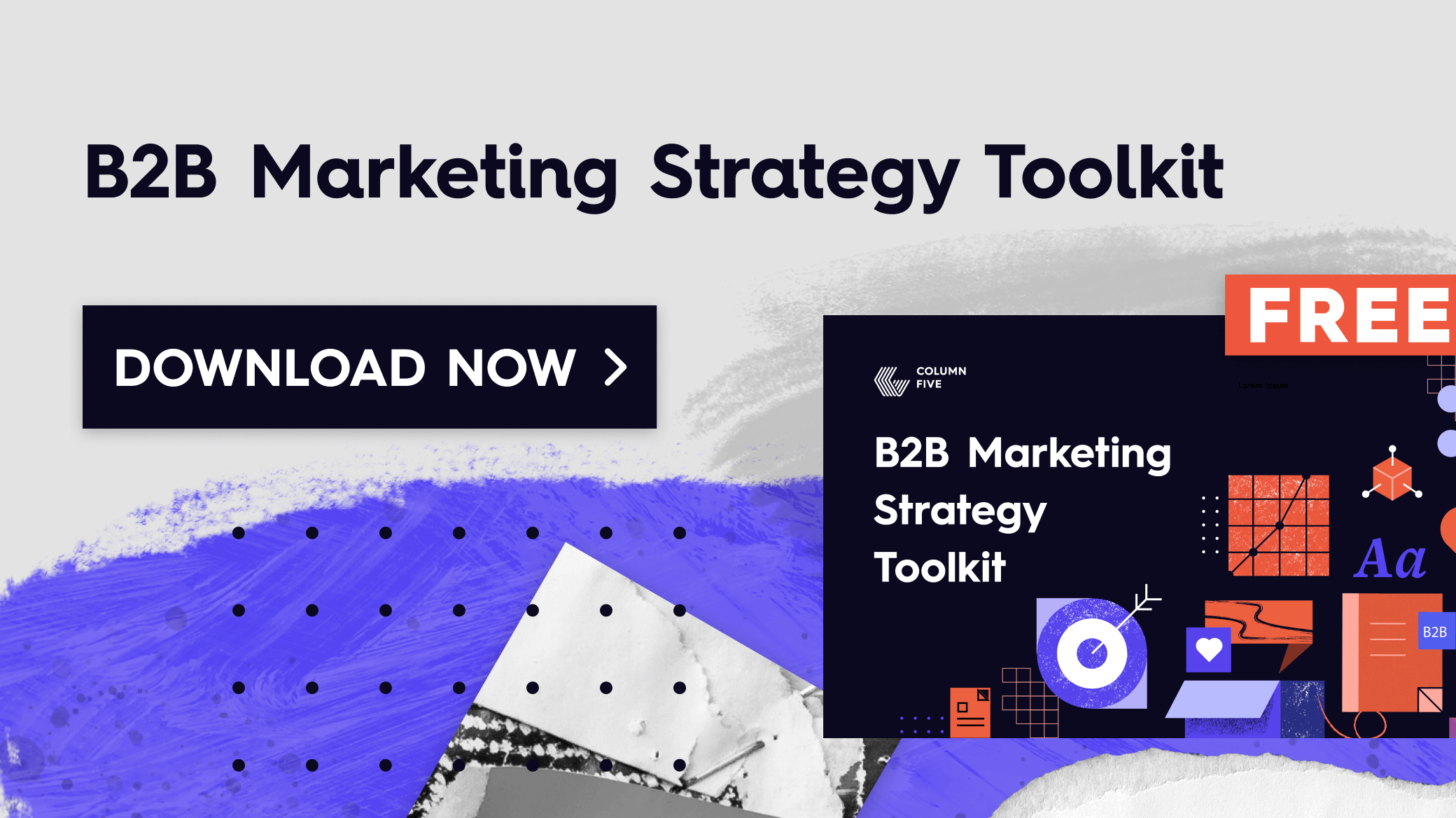If there’s one mistake we’ve seen our partners make over and over, it’s focusing more on product development than brand development. And, look, I get it. You need constant innovation to keep up. It’s why “product, product, product” has become the startup founder’s mantra.
But in the tech industry, building a superior product/service is simply the point of entry. As competition gets stiffer and innovation cycles become shorter, product alone won’t bring you longevity. You need something more. That’s why we on the marketing side are shouting a different mantra: “brand, brand, brand.” If you ignore this crucial component in your marketing, you make it very hard to win in the long run.

Why Product Marketing Fails in SaaS
Focusing on product isn’t inherently bad. But over-focusing on product can make you miss growth opportunities outside of that microsphere. Why? Because people don’t actually buy products. They buy the promise of how things will be better post-purchase.
Promise > Product
You can’t just build a product and hope people buy it. You can’t just build a product and tell your team to sell by rattling off all of the bells and whistles behind how it works. One of the basics of marketing is that you should sell benefits, not features. I’d take that a step further. You should sell to what makes people buy: emotions. Ultimately, how do you make them feel?
“Feeling” extends not only to the product and its benefits but also to the way people feel about your brand. The more they know who you are, what you care about, and what you do and don’t stand for, the more eager they are to support you. If you eschew brand-building and only put your eggs in the product basket, you won’t be able to communicate this key part of your identity and create those core connections.
No matter how good your product is, if people don’t feel good about your brand, they will never buy.
Most importantly, you won’t truly be able to stand out in the marketplace. Building a brand is the opportunity to sustainably differentiate. Brands that ignore this opportunity will be forced to compete on features or price, usually both. Either way, these alternatives represent a race to the bottom and make it impossible to be a category creator or leader.
And while a founder or CEO might think all this talk about brand-building is frivolous and a distraction from product innovation, brand-building is actually the most powerful fuel for the type of innovation they’re looking for.
How Brand Influences the Stages of Product Development
Every company is at a different stage of product maturity. Although the instinct is to focus on product first, nurturing your brand first is actually the most effective way to evolve your product intentionally.
Taking a brand-first approach to building your business can save you money, time, and energy.
Why? Because when you have a strong brand foundation and understanding of who you are, what you stand for, and what you care about, you can make better decisions about how to invest in and grow your product in a way that is perfectly aligned to your business goals and the future you’re trying to build.
The 3 benefits of brand-influenced product development:
- Informed product development
- Ambitious product development
- Clarified product development
Here’s what I mean:
Informed Product Development
Obviously, you can’t build a company without a product—and you can’t set it and forget it once you launch. To succeed, you need to know who you’re building for, why you’re building, and why people should lend their time and talents to help you build it. Building your brand helps you clarify these elements, setting you on the right path from the jump.
It’s akin to taking a rocket to the moon. If the launch trajectory is aimed off target by 1 degree, you’ll end up 4,169 miles off course. Likewise, if your early efforts are off the mark, you may end up much more off course than you anticipated in one, two, or five years.
Counter to popular belief, brand-building positively influences product development vs. being a distraction from it (as many hard-core software folks have opined over the years).
Ambitious Product Development
A company’s success lies in both its customers and its employees. Even with a solid launch and early buzz, sustainable success relies on the people behind your brand—the ones who lend their skills and critical thinking to your business. As markets become more competitive, they need a reason to show up each day and innovate your product.
The first step in brand-building is getting your house in order; this involves taking a hard look at your Brand Heart, which includes your vision, purpose, mission, and values. This set of beliefs is your starting point, your North star, and the blueprint for how you run your business.
In the same way that you must build a brand that resonates with would-be buyers in the marketplace, you need a brand mission that inspires current and future employees to show up each day.
65% of employees cite company culture as one of the main reasons they stay in their job.
—Glassdoor’s Mission & Culture Survey 2019
Strong brands are able to articulate this simply and effectively:
- Asana: “To help humanity thrive by enabling all teams to work together effortlessly.”
- Intuit: “To improve its customers’ financial lives so profoundly, they couldn’t imagine going back to the old way.”
- Microsoft: “To enable people and businesses throughout the world to realize their full potential.”
With a Mission on this level, you can plant a flag both with future customers and employees, inviting them to play a role in this meaningful venture. This sense of shared purpose directly contributes to employee engagement and innovation, helping you produce better products than your competition—and better profits along the way.
Purpose-driven companies financially outperform the market by 42%.
—2018 DDI Frontline Leader Project
Clarified Product Development
A strong brand will keep your team rallied around a shared purpose and walking on the right path, but getting people excited is half the battle. Knowing exactly what you do and don’t want to build is key to protect that precious talent. We’ve seen too many companies without a well-defined mission say yes to doing too much. The result? They struggle with a bloated product roster, a burnt-out team, and an alienated audience.
But with a clarified brand, you can return to your foundation again and again to realign your team, make better business decisions, and—yes—even build fewer but better products.
How to Put Brand-Building to Work for Your Company
If your company has been more product-focused to this point, I understand the hesitation to switch gears to brand-building. But I would reframe that not as pivoting but expanding your focus to ensure your brand foundation is solid and your marketing machine is built to make the most impact. A few tips to do that:
- Strengthen your brand foundation. Make sure your Brand Heart, messaging, and visual identity are aligned. Use our guide to build a brand strategy, which includes a free toolkit to help you document every element and keep your team on the same page.
- Focus on strong storytelling. The company that tells the most interesting, compelling story will win. The strongest stories center on how your customers’ lives will start improving once they make the purchase. Again, think of your audience’s desired post-purchase feeling. What is the emotion you’re selling? How can you speak to your audience’s wants and needs? Identify what makes you unique, articulate it through brand messaging, and create high-value content to tell that story.
- Be the best version of your brand. The company that invests the most in brand-building will likely beat those who haven’t, but the company that has built the best version of their brand will likely beat a whole field of competition. What does it mean to be the best? It means investing in your culture, sharing your values, and walking your talk.
Ultimately, remember that building a brand doesn’t guarantee success, but not building a brand all but guarantees failure. That’s not to say you can’t build a business that can operate profitably without taking brand-building seriously. However, in the SaaS market, on a long enough timeline, competitive products and features will eventually mirror the competition. In that context, if you haven’t invested in building a brand that tells a story that resonates with folks, you will fail to impact—much less influence—your potential customer.
Of course, I know not every brand has the knowledge, bandwidth, or perspective to re-align their brand alone. If you need some outside help, take a look at our brand strategy FAQs or reach out. We’d love to help you find and tell your best brand stories.





